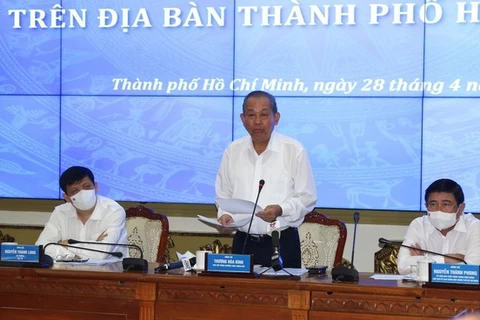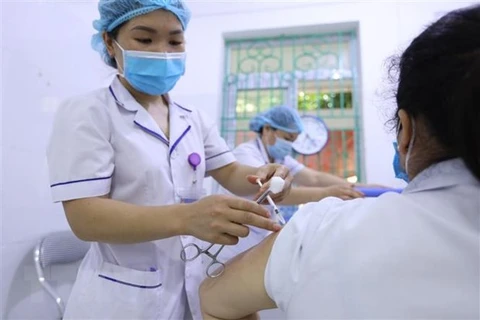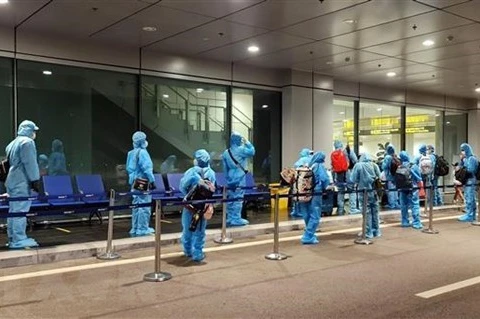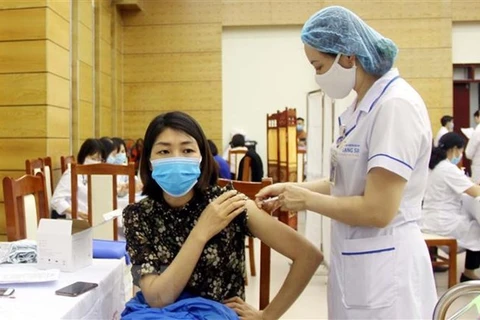Hanoi (VNS/VNA) - The Ministry of Health (MoH) has introduced several changes to procedures for the diagnosis, treatment and hospital discharge for COVID-19 patients and called on hospitals to ensure they have sufficient oxygen reserves.
At an online conference on COVID-19 prevention and vaccination safety on April 28 morning, Associate Professor Luong Ngoc Khue, Director of the Medical Service Administration under the MoH, said in the context of the spread of COVID-19 in the world, the risk of pandemic infiltration into Vietnam was very great.
Lockdowns have been imposed in neighbouring countries like Laos and Cambodia, while the virus is also spreading rapidly in regional nations like Indonesia and the Philippines.
After more than a year since it first broke out, the SARS-CoV-2 virus has continuously changed, creating many different variants, making the virus more infectious and difficult to control.
Virus studies are becoming clearer, so Vietnam has rebuilt the treatment regimen for SARS-CoV-2. This is the fifth update since March 2020.
In the new regimen, the MoH classifies five clinical levels, from asymptomatic, mild, moderate, severe to critical. If the patient has signs of pneumonia they are classified as moderate.
Nguyen Van Kinh, Chairman of the Vietnam Society of Infectious Diseases, said in the fifth regimen, treatment must be one step ahead to prevent patients from becoming critically ill, so close monitoring of patients is a top priority.
To reduce the incidence of serious illness, the MoH recommends as soon as the patient's blood oxygen level falls below 92 percent, consideration should be given to appointing high-flow oxygenation through the nasal passages early or non-invasive mechanical ventilation.
“India had a lot of fatalities because there were no oxygen reserves, people with serious illness had no oxygen and drowned on land. Therefore, medical facilities must pay attention to oxygen reserves," Kinh said.
To be discharged, previous regimens required patients to have three consecutive negative tests, each at least 24 hours apart. In the latest regimen, the MoH changed the regulations.
Now, patients are eligible for discharge from the hospital after at least 14 days of treatment and with two negative tests, each 48-72 hours apart and the last sample must be taken no more than 24 hours from the time of discharge./.
At an online conference on COVID-19 prevention and vaccination safety on April 28 morning, Associate Professor Luong Ngoc Khue, Director of the Medical Service Administration under the MoH, said in the context of the spread of COVID-19 in the world, the risk of pandemic infiltration into Vietnam was very great.
Lockdowns have been imposed in neighbouring countries like Laos and Cambodia, while the virus is also spreading rapidly in regional nations like Indonesia and the Philippines.
After more than a year since it first broke out, the SARS-CoV-2 virus has continuously changed, creating many different variants, making the virus more infectious and difficult to control.
Virus studies are becoming clearer, so Vietnam has rebuilt the treatment regimen for SARS-CoV-2. This is the fifth update since March 2020.
In the new regimen, the MoH classifies five clinical levels, from asymptomatic, mild, moderate, severe to critical. If the patient has signs of pneumonia they are classified as moderate.
Nguyen Van Kinh, Chairman of the Vietnam Society of Infectious Diseases, said in the fifth regimen, treatment must be one step ahead to prevent patients from becoming critically ill, so close monitoring of patients is a top priority.
To reduce the incidence of serious illness, the MoH recommends as soon as the patient's blood oxygen level falls below 92 percent, consideration should be given to appointing high-flow oxygenation through the nasal passages early or non-invasive mechanical ventilation.
“India had a lot of fatalities because there were no oxygen reserves, people with serious illness had no oxygen and drowned on land. Therefore, medical facilities must pay attention to oxygen reserves," Kinh said.
To be discharged, previous regimens required patients to have three consecutive negative tests, each at least 24 hours apart. In the latest regimen, the MoH changed the regulations.
Now, patients are eligible for discharge from the hospital after at least 14 days of treatment and with two negative tests, each 48-72 hours apart and the last sample must be taken no more than 24 hours from the time of discharge./.
VNA
























